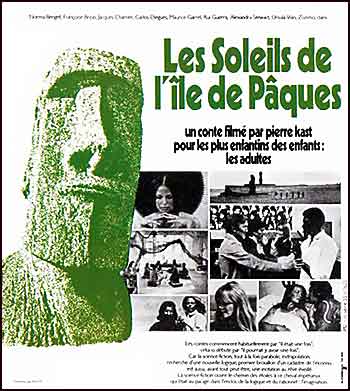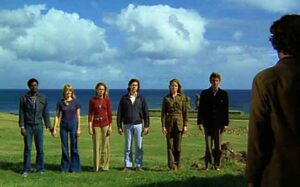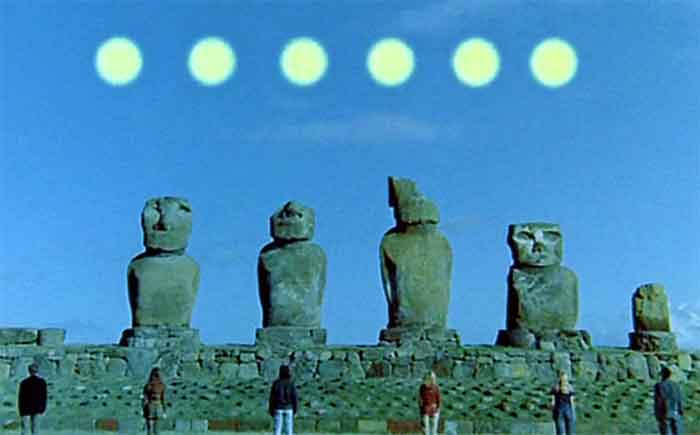 This ambitious French science fiction drama from 1972, lensed in France, Brazil and Chile, can be viewed as the little-known forerunner of CLOSE ENOUNTERS OF THE THIRD KIND, with a similarly themed narrative. It’s also a counterculture buff’s wet dream, touching upon astrology, extraterrestrial contact, telepathy, Wilhelm Reich, African mysticism and the theories of CHARIOTS OF THE GODS’ Erich von Daniken (or more accurately his French counterpart Robert Charroux, of ONE HUNDRED THOUSAND YEARS OF MAN’S UNKNOWN HISTORY). There are even plugs for communal living and the benefits of hippiedom. But is the film any good? Not really.
This ambitious French science fiction drama from 1972, lensed in France, Brazil and Chile, can be viewed as the little-known forerunner of CLOSE ENOUNTERS OF THE THIRD KIND, with a similarly themed narrative. It’s also a counterculture buff’s wet dream, touching upon astrology, extraterrestrial contact, telepathy, Wilhelm Reich, African mysticism and the theories of CHARIOTS OF THE GODS’ Erich von Daniken (or more accurately his French counterpart Robert Charroux, of ONE HUNDRED THOUSAND YEARS OF MAN’S UNKNOWN HISTORY). There are even plugs for communal living and the benefits of hippiedom. But is the film any good? Not really.
…the little-known forerunner of CLOSE ENOUNTERS OF THE THIRD KIND.
In France Maurice (Maurice Garrel), a physicist, uses the ancient science of Geomancy to study the effects of solar energy. He’s tormented by odd and disquieting dreams, after which he awakens to find an odd circular encrustation on the palm of his left hand.
Norma (Norma Bengell), an astronomer, is in Brazil studying some mysterious church statues. By measuring the statues’ circumferences and aligning them with the stars she discovers a celestial configuration. She also suffers from odd dreams that leave a mark on her palm similar to that afflicting Maurice.
In a Chilean desert Alexandra (Alexandra Stewart), a horse breeder, is confronted with ancient hieroglyphs that nobody has ever been able to explain. While flying over them in an airplane she goes into a trance and experiences another of those now-familiar dreams—and awakens to find herself afflicted with a by-now familiar mark on her palm.
From there we look in on Francoise (Francoise Brion), an Easter Island obsessed ethnologist on a boat trip in Polynesia. She has the dream while dozing in her hotel room, and, of course, gets a mark on her palm.
Helvio (Marcello Romo), an entomologist, is travelling in central Chile. On the verge of a great discovery involving insect eggs he has the dream and gets the mark, and uses his scientific expertise to examine it—but is unable to formulate any real conclusion about the mark’s origins or its properties.
Irenio (Zozimo Bulbul), an African priest, is engaging in a ritual in which he purports to speak in the voice of a god, but in the middle of the ceremony he’s overcome by the same dream everyone else has been experiencing. He awakens with (you guessed it) a mark on his palm.
Back to Alexandra, who is visiting her boyfriend Alain (Jacques Charrier), a Chile-based French psychoanalyst; she reveals to him that she’s become telekinetic, and demonstrates this by moving a pencil with her mind. Norma, meanwhile, tries to convince her university superiors that her configurations have merit—and it seems they really do, forming a map that leads directly to Easter Island.
Maurice, Irenio and Norma fly to Chile, while Francoise, intending to travel to Paris, impulsively flies to Chile herself—after an hour-long stopover in Easter Island, where she’s overcome with an odd sense of anxiety. All four meet up in Chile, where they, and also Alexandra and Helvio, are psychically drawn to one another. It’s determined that they’ll need to travel via ship to Easter Island, where the solution to the mystery binding them appears to reside.
Alain tags along on the voyage, which deposits the seven of them on the shores of Easter Island. There they find themselves faced with the island’s odd statues, and are assailed by another dream, which inspires them to descend into the bowels of a cave. There they meet a shadowy personage emerging “from the depths of time,” who telepathically reveals to them the solution they’ve been seeking.
It seems aliens have been secretly monitoring the Earth, and making contact with its inhabitants every 5,000 years; the latest contact is rather important, as it’s set to determine if the human race is ready for the next stage of its evolution. The promised close encounter is set occur very soon, with the six protagonists serving as the vessel through which the aliens are make contact. Will the aliens like what they find?
The climax, unfortunately, is a disappointment, particularly as the entirety of the preceding film serves as a build-up to it. Shockingly nonchalant and uneventful, the film’s inert finale is very nearly the inverse of the special effects lightshows that concluded 2001: A SPACE ODYSSEY and CLOSE ENCOUNTERS OF THE THIRD KIND. Further disappointment occurs in the dream/hallucination sequences, which consist of still photo montages mixed with primitive (by modern standards) animation.
In contrast to what we’ve come to expect from European arthouse cinema (even of the science fiction variety), THE SUNS OF EASTER ISLAND moves fast—make that too fast, especially in light of the thoughtful and contemplative narrative, which often feels like it’s stuck in permanent fast forward. The film also contains a wall-to-wall soundtrack marked by narration that never lets up, and contains a number of weird/annoying electronic sound effects.
To be sure, France has put out some quality science fiction films, including LA JETEE and JE T’AIME, JE T’AIME, but most such efforts are pretty scrappy. Such is the case with THE SUNS OF EASTER ISLAND, which contains some striking footage of the statues of Easter Island and other natural wonders but fails to do the genre, or writer-director Pierre Kast’s own outsized ambitions, justice.
Vital Statistics
THE SUNS OF EASTER ISLAND (LES SOLEILS DEL L’ILE DE PAQUES)
Alexandra Film/Luiz Carlos Barreto Producoes Cinematograficas/Telecinema Helvio Soto
Director: Pierre Kast
Producer: Helvio Soto
Screenplay: Pierre Kast
Cinematography: Silvio Caiozzi, Jaen Collomb, Jose Antonio Ventura
Editing: Georges Klotz
Cast: Norma Bengall, Francoise Brion, Jacques Charrier, Maurice Garrel, Marcelo Romo, Alexandra Stewart, Zozimo Bulbul, Ursula Kubler, Carlos Diegues, Ruy Guerra


